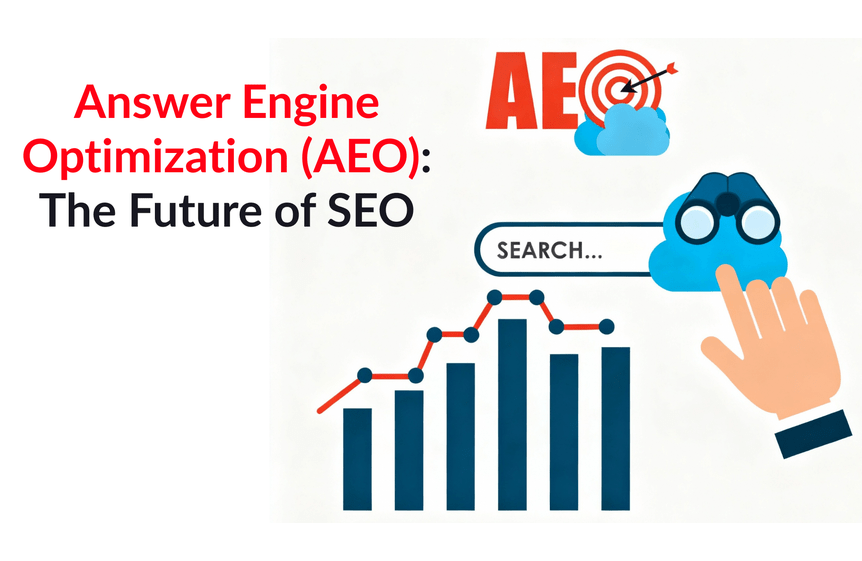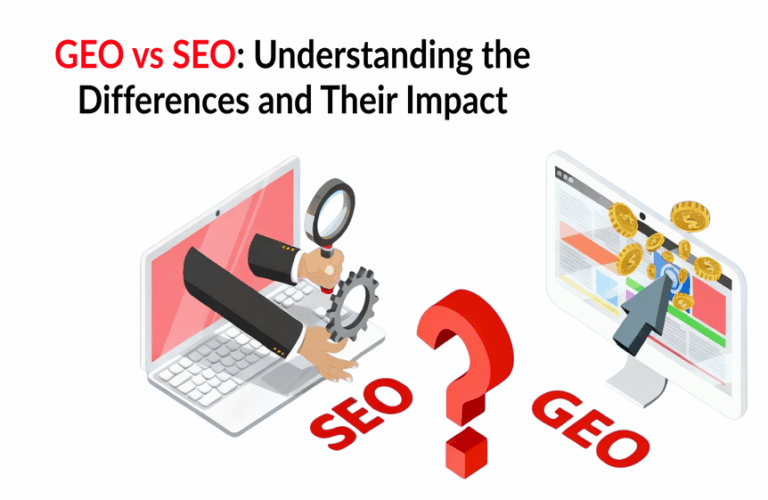Answer Engine Optimization (AEO): The Future of SEO
Nowadays, websites need more than ranking a single page on Google. The next step is about satisfying answers in addition to the overall results. This is where Answer Engine Optimization helps.
What is AEO exactly? It is a modified form of SEO that connects on-page SEO, technical SEO, and smart content strategy to meet modern search behavior. As an organization, if you want to improve your digital footprint, Opositive makes use of AI for SEO insights, uses advanced tools, and improves content & architecture to deliver maximum impact.
What is AEO?
Answer Engine Optimization is the process of creating and organizing content such that the content serves as a direct answer as perceived by users. With respect to traditional link-based SERPs, it is typical to click through multiple links. Answer Engine Optimization is structured for environments where the answer is delivered upfront in the form of featured snippets, AI overviews, and voice assistants.
Why AEO Matters
The concept of search behavior is changing. Most queries end without a click because the answer is available on the results page itself. Moreover, with the help of AI-driven platforms and voice search, users are looking for concise, conversational answers and not going through multiple links. AEO makes sure that your content is selected for zero-click answers.
AEO vs Traditional SEO
SEO that was used traditionally focused on ranking web pages in the available list of links through practices like on-page SEO, keyword optimization, and link building. On the other hand, AEO focuses on serving the answer directly with the help of structured data, Q&A formats, and FAQs.
Why Answer Engine Optimization Matters for Businesses
1. Increased Visibility
Search results nowadays are generated and delivered by AI models. Therefore, businesses are expected to adapt to the rising technology of AEO. Traditional SEO aims to focus mainly on ranking web pages. Answer Engine Optimization aims to present your brand as the ultimate source for direct, instant answers. When your content and structure are generated according to the way intelligent systems parse queries, you increase your chances of showing up in zero-click results.
2. Better Brand Trust Through Citations
When AI-powered search engines reference your domain as a reliable source of answers, it improves your brand’s authority. When your brand is cited by a system that is capable of delivering concise, direct responses, it builds trust among users. For a forward-thinking SEO company like Opositive.io, the integration of AEO into their SEO services means clients gain better visibility.
3. Voice Search & Conversational Visibility
Conversational bots and voice assistants now power billions of day-to-day queries. They rarely link to a list of results; they report to a single answer. AEO optimization helps businesses appear in chat-based or spoken interfaces to turn searchers into listeners who become users. By thinking with respect to entire questions, natural context and phrasing, brands are able to prepare themselves for the change.
4. Early-mover Advantages
Companies that adopt AEO can gain an ample advantage in terms of competition. While most brands still prefer backlinks and clicks, the use of the question-answer format helps you get prime placement in modern SERP real estate. For an experienced SEO agency, this is an opportunity to stand out. They can combine AI-powered SEO tools with human insight to offer ad-free growth.
Answer Engine Optimization Fundamentals
1. Natural-language Intent & Entities
AEO starts with understanding the reason behind someone’s search, what they are asking, and then creating content to deliver the direct answer. Through the identification and mapping of natural-language intent, you can align your SEO work according to what users are typing.
Entities are also important. Search engines recognize them, connect them, and deliver concise answers with the help of knowledge panels or snippets. When you optimize for intent and entities together, you connect with the question-answer relevance.
2. Structured Data and Knowledge Graph
Structured data connects your content and the way search engines organize knowledge. Through the embedding of JSON-LD markup (like Article, FAQs, How-tos, and Organization), you indicate exactly what every section of the page is about. This feeds your content into a knowledge graph to offer you insight into improved results, like featured snippets or answer boxes.
3. Content Formats
If you wish to deliver AEO-friendly content, format is also important. AEO-optimized pages prioritize clear definitions, bullet lists, tables, step-by-step instructions, and concise summaries. These content formats make it easy for both machines and users to scan, interpret, and analyze your content. When you write with proper structure and clarity, you improve the chances that an engine will highlight your answer directly in the search results.
4. EEAT and Brand Authority
Search engines increasingly depend on signals like Experience, Expertise, Authoritativeness, and Trustworthiness to decide which answers to rank. For AEO, your content should reflect proper authority, author bios to show credibility, organization pages to validate your identity, and citations to back your claims.
How to Optimize AEO
1. Question-led Headings
Start by converting user queries into proper headings. For example, you can use “What is AEO” or “How to optimize AEO?” This practice helps your page serve both on-page SEO and AI-driven discovery at the same time.
2. Answer-first Summary Box
Try to include a concise, relevant answer of around 40-60 words after each heading. This technique makes sure that answer engines are directly able to identify your page as a reliable source of information and improve visibility in voice search results and conversational AI.
3. Schema
Schema makeup is important for AEO optimization. You should make use of relevant FAQs, breadcrumbs, speakable, Q&A, How-to, and Organization schemas to depict structured content. These elements help AI understand your context and improve how your content is cited or summarized.
4. Data Tables & Checklists
LLMs prefer structured, easy-to-scan data. Well-defined checklists, tables, and bullet points make your content machine-readable and improve user experience.
5. Voice & Conversational UX
Choose a conversational and concise writing style. Use natural sentence flow, proper punctuation, and SSML hints for better text-to-speech rendering. This helps with effective AI content consumption with the help of voice assistants.
6. Citation-worthiness
AI models look for content that is verifiable. Include credible sources, outbound links, and your own researched data. This improves overall trust and increases your chances of being referenced by search engines.
7. Internal Linking
Build semantic clusters and interlink related pages around a single definitive answer. This helps AI tools go through your expertise effectively and ensure topical authority.
Answer Engine Optimization Keyword Strategy
1. ‘What is AEO’ and Definitional Queries
Start by looking into foundational searches like ‘What is AEO’ or ‘What is Answer Engine Optimization?” These definition-based keywords set topical authority and connect your content with users and AI engines looking for clear explanations or comparions between AEO vs SEO.
2. Task-based Queries
Include intent-rich, action-centric keywords like ‘How to optimize AEO,’ ‘AEO checklist,’ or ‘AEO framework,’ which correlate with on-page SEO and technical SEO.
3. Long-tail, Conversational Patterns
AI-driven platforms prioritize natural phrasing. You should aim to target long-tail queries like ‘Is AEO better than SEO’ to highlight real conversation and intent.
4. SERP + AI Card Mapping
Try mapping content for People Also Ask, Featured Snippets, and AI Overviews. This will ensure visibility across AI SEO tools, search experiences, and chat-based results.
Answer Engine Optimization Content Structure
1. Pillar: What is AEO
Answer Engine Optimization aims to answer ‘What is AEO’ to drive direct and accurate answers to user-specific questions. This section should explain how AEO differs from SEO and why it is becoming increasingly important. When you understand these pillar concepts, you can develop an AEO-friendly site.
2. Cluster: How to Optimize SEO
This section aims to cover the real-world steps on ‘How to Optimize AEO.’ You can go ahead with applying schema for HowTo and FAQs, creating answers that satisfy EEAT, and layering content clusters to help engines fetch relevant answers. You can use proper content clusters to improve your overall strategy, indexing, and convert queries into clicks.
3. Cluster: AEO vs SEO
In this comparison cluster, you will go through the differences between AEO vs SEO. The section should focus on how AEO emphasizes answer-delivery and not keyword matching in the case of SEO.
4. Cluster: Generative/Answer Engines
Generative and answer engines, like Perlexity & ChatGPT, are modifying how users ask questions and how answers are given. This cluster aims to look into platform-specific dos and don’ts for content creators. It also analyzes how a reliable SEO company like Opositive.io can help integrate AI for SEO to anticipate questions effectively.
Technical Answer Engine Optimization
1. Core Schema
Use structured data like FAQ, How To, Article, Product, and Organization schema to help AI easily get relevant answers. For example, FAQs offer quick responses, and the HowTo markup supports step-by-step answers.
2. Page Experience
Focus on Core Web Vitals. At the same time, it is also important to maintain a clean DOM, use accessible headings, and deliver mobile & voice compatibility to boost visibility in search & voice-based results.
3. Crawlability
Optimize elements like sitemaps, robots.txt, canonical tags, and hreflang to make sure that AI is capable of crawling, interpreting, and indexing answer-centric pages effectively.
4. Speakable & Voice Considerations
If you wish to implement voice-specific SEO, include Speakable Schema and conversational content to help virtual assistants deliver your answers accurately.
Distribution for AEO
1. Multi-format Repurposing
Transform your answer-rich content into a short-explainer video, a slide deck, or an infographic to distribute the same content into different formats. This helps you reach target audiences who prefer social sharing or visual learning. Each format should support the other and build a proper system around your answer.
2. Citable Assets
Create original assets like unique statistics, downloadable templates, PDFs, or calculators that serve as canonical references. These become relevant resources that others will cite to boost your authority and recognize your content as trustworthy.
3. Digital PR
With the help of digital PR, you can get authoritative links and mentions from credible websites that are trusted by search engines and language models.
AEO Measurement & KPIs
1. Leading Indicators
These are early signs that you are succeeding in the answer domain. Track the number and share of featured snippets your site has earned, appearances in PAA boxes, FAQ impressions, and if you show up in AI Overviews. These indicators depict that search engines are recognizing your content as a reliable source of answers.
2. AI Citation Tracking
AI systems now increasingly extract from the web to create responses. Therefore, you should monitor your brand’s presence in these outputs. Understand how often tools like Perplexity or ChatGPT cite your pages, track the ‘source included’ rate, and watch your brand come up in answer-engine results.
3. Engagement Outcomes
Analyze assist clicks, saves/shares/copies of answer content, improvement in brand-search volume, and demo sign-ups for those answer-driven sessions.
4. Experiment Design
Execute experiments on answer-box length, compare table-format answers, and test different schema variants. When you iterate format & structure, you understand what boosts visibility and engagement.
| Metric Type | KPI Example | What It Indicates |
| Leading Indicator | Featured snippets, PAA visibility | Early signs of answer selection |
| AI Citation Tracking | Mentions in ChatGPT or Perplexity | Authority in AI-generated results |
| Engagement | Clicks, saves, brand searches | Content relevance & trust |
| Experimentation | Schema variant tests | Content format performance |
Common Mistakes to Avoid
1. Ignoring Structured Data or Schema Conflicts
Schema markup and structured data help search engines understand your content and present it in the form of a direct answer. If you do not pay attention to these aspects, you might miss out on the expected ‘answer’ result slot.
2. Over-optimizing Definitions
When you over-stuff phrases like ‘What is AEO’ or ‘Answer Engine Optimization’ repeatedly in awkward places, you reduce readability and might trigger algorithmic penalties. You should use natural language and structured descriptions.
3. Not Updating updated Information
Answer engines focus on content that is both timely and accurate. Old statistics or old tool references can minimize your chances of being selected as a featured answer. Revisit pages regularly, refresh existing data, and add recent examples to be up-to-date.
4. Not Focusing on EEAT
If your content does not feature author bios, credible sources, or real-world examples, search engines might regard it as unreliable. Make use of expert insights, cite proper data, and link to reputable references to improve your answer’s position.
Best Tools for Answer Engine Optimization
The right tools can help implement an effective SEO strategy. You should use schema markup generators or analytics tools to optimize and measure your content.
1. Schema Markup Generators
Leading generators like TechnicalSEO Schema Generator, Merkle Schema Markup Generator, and specific schema modules in Rank Math make it simpler to build JSON-LD markup for FAQs, product data, and HowTo content.
2. AEO Keyword & Intent Research Tools
Tools like AlsoAsked go through question clusters. At the same time, Surfer SEO and SEMrush look into keyword value & intent. You can use Frase to assist with mapping content to topic relevance and user questions.
3. AI Citation Tracking Tools
Tools like AIOSEO and Perplexity AI help you monitor how often and how your brand is referenced across the web. You can also use tools like ChatGPT to get citation queries internally.
4. Analytics Tools
Leading platforms like Google Search Console help you understand which queries initiate pages and how they perform in snippets. Ahrefs offers detailed keyword, ranking, and link analysis. You can use LookerStudio to come up with customized dashboards to understand how SEO efforts affect traffic & conversions.
Conclusion
AEO continues to determine the future of visibility. With the right use of on-page SEO, technical SEO, and AI-supported insights, your brand can rank high. You can consider partnering with a forward-thinking SEO company in India like Opositive to optimize your digital presence.
FAQs
Does AEO replace SEO?
AEO does not aim to replace SEO. It only enhances the latter. SEO focuses on ranking in search results. AEO helps your content get selected directly in the form of an answer by AI-supported engines and voice assistants.
How does AEO help with AI citations?
With the help of AEO, you can create structured, semantically clear, and credible content. This helps AI tools cite your brand as a reliable source while generating answers.
Does AEO impact organic traffic?
When you optimize for AEO, it improves qualified organic traffic by improving visibility in voice search, featured snippets, and AI-centric results.
What’s the difference between AEO and Featured Snippets?
Featured snippets are a result of AEO. AEO aims to focus on understanding structure, intent, and context to make your content eligible for snippets.
Does AEO improve visibility in Perplexity and ChatGPT?
When you optimize content with citations, clear answers, and schema markup through AEO, it enhances your chances of being referenced by AI tools or platforms.














